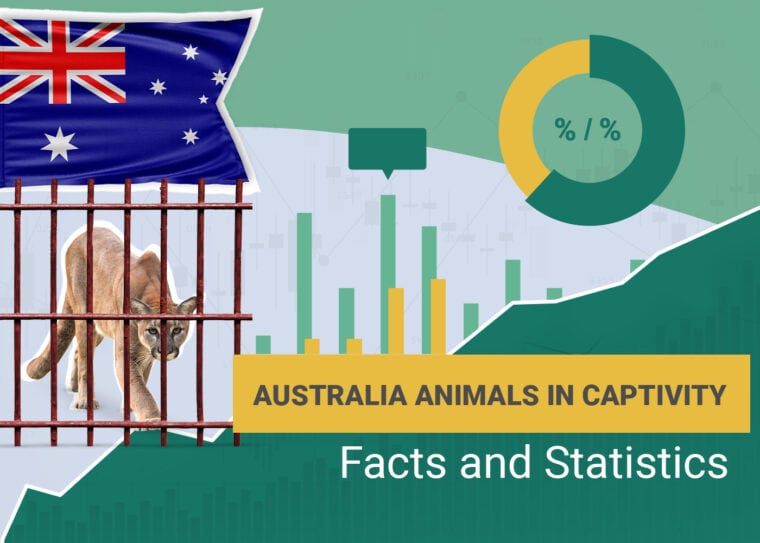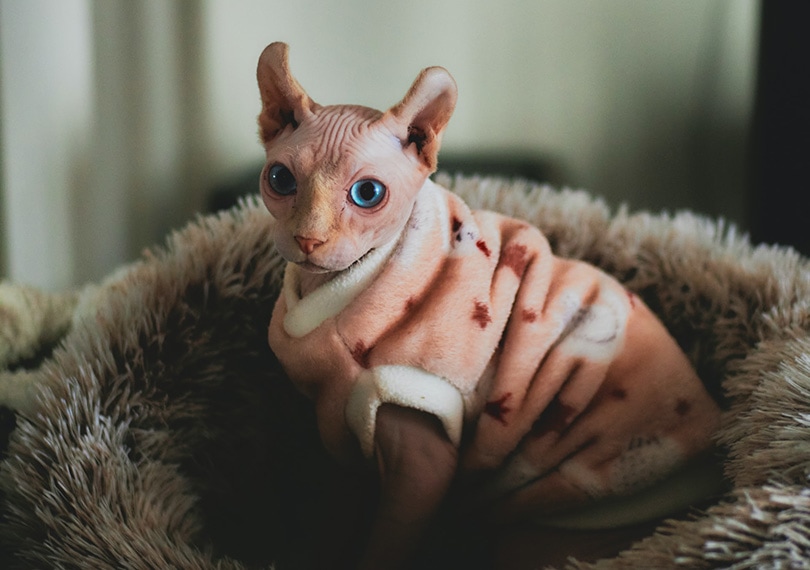
Click to Skip Ahead
Note: This article’s statistics come from third-party sources and do not represent the opinions of this website.
Australia is one of the largest countries in the world, and its massive land mass contains a variety of habitats, from mountains to deserts and tropical rainforests. This diversity, as well as the country’s size, means that it is home to an incredible number and range of animals.
In particular, it is home to more than 700 species of reptiles, while the kangaroo is not only the country’s national animal but is also one of its most widely recognized features. Specifically, it is the red kangaroo that is the national animal, and this is the largest land mammal in Australia, too. Other animals the country is known for include wallabies and wombats, both of which, like the kangaroo, are marsupials, along with the koala.
There are more than 100 zoos in Australia and potentially more than 200 private and public centres that keep captive animals of different kinds. Although there is no known figure for the exact number of captive animals, Australia Zoo alone claims to be home to more than 1,200 animals, while Taronga zoo has more than 4,000, which means there are likely tens of thousands of captive animals. While proponents of zoos and other centres claim that they provide education and help with conservation, critics state that zoos do very little to aid in conservation and that most people attend zoos for entertainment rather than education.
Below are 10 statistics and figures related to captive animals in Australia, including information on visitor numbers and, where available, animal numbers, as well as statistics on the work that zoos do.
Top 10 Australian Animals in Captivity Statistics
- There are more than 100 zoos in Australia.
- More than 8 million people visit Australian zoos every year.
- 20 million people visit zoos and aquariums in Australia.
- A third of visitors to Australian zoos are from overseas.
- Taronga Zoo has more than 4,000 animals.
- Taronga Zoo has released more than 50,000 animals into the wild.
- Some zoos and aquariums commit to investing between 6 and 11.5% of their budget in conservation.
- Less than 3% of zoo profits go to conservation efforts.
- Most animal species live longer in captivity than in the wild.
- Elephants only live half as long in captivity as in the wild.

Zoos and Aquariums
1. There are more than 100 zoos in Australia.
(CRC Tourism)
There are more than 100 zoos across Australia. This doesn’t include aquariums, some private zoos, or other venues that have captive animals. Zoos typically keep animals in cages and enclosures. Wildlife parks have fenced-off areas but allow more room for the animal to roam, and the visitors stay in their cars while driving through the enclosures. Public zoos are those that are open to the public, while a private zoo is one kept by a private individual. Private zoos may be open to the public.

2. More than 8 million people visit Australian zoos every year.
(CRC Tourism)
Statistics relating to the total number of people visiting zoos in Australia every year are hard to come by, but the most recent figures show that more than 8 million people visited 53 zoos and 12 aquariums in 1996–1997. They paid an average admission price of $8.70 per person, and the establishments raised more than $140 million. While nearly half of this money came from admissions, $26 million came from government funding, and nearly $30 million from the sale of goods.
3. 20 million people visit zoos and aquariums in Australia.
(The Guardian)
More recently, figures show that 20 million people visited zoos and aquariums each year before COVID-19 lockdowns. This figure does include aquariums, which also keep animals in captivity. Furthermore, another 2.1 million people visited similar establishments in New Zealand.
Animals in Captivity
4. A third of visitors to Australian zoos are from overseas.
(CRC Tourism)
Of the 8 million people that visited Australia’s zoos and aquariums, two-thirds of them were from Australia. The remaining one-third were visitors from overseas, likely hoping to catch a glimpse of endemic and local wildlife in safe surroundings.
5. Taronga zoo has more than 4,000 animals.
(Sydney Expert)
Taronga Zoo was established more than 100 years ago and is situated on a hill just above Sydney harbour, making it a popular spot for tourists and visitors. It is considered the largest zoo in Australia and is home to more than 4,000 animals. Among its somewhat unique exhibits is a new tiger enclosure. Visitors take a virtual plane tour across Indonesia, where they are shown the effects of deforestation.

Zoo Conservation and Care
6. Taronga zoo has released more than 50,000 animals into the wild.
(The Guardian)
Taronga zoo claims to have released more than 50,000 animals into the wild and has also committed to protecting 10 endangered species in its care within the next 10 years. Another group, Zoos Victoria, which includes Melbourne Zoo and Healesville Sanctuary, has set its targets higher, aiming to protect 27 endangered species.
7. Some zoos and aquariums commit to investing between 6 and 11.5% of their budget on conservation.
(The Guardian)
Critics claim that while zoos claim conservation to be one of their biggest benefits, the actual work they do for conservationism falls some way short. According to figures, there are some zoos (Taronga) that invest as much as 11.5% of their income on conservation plans and work. Zoos SA invests about 6%.

8. Less than 3% of zoo profits go to conservation efforts.
(National Geographic)
The World Association of Zoos and Aquaria has set a target for all of its member zoos to invest at least 3% of their budget on ex-situ conservation work. Ex-situ conservation is conservation that occurs away from the location of the zoo and typically means the protection of habitat and wildlife in the wild. Despite this target, it is estimated that less than 3% of all zoo profits go towards conservation efforts.
9. Most animal species live longer in captivity than in the wild.
(Discover Wildlife)
One study found that 80% of animal species in the care of zoos live longer lives than they do in the wild. The study looked at 50 species of mammals and, therefore, did not include other species and types of animals, and it did not look at the state and health of the animals while they were in captivity. This was especially obvious in the smaller species of mammals that typically have a shorter lifespan.

10. Elephants only live half as long in captivity as in the wild
(The Guardian)
In contrast, long-living elephants that have no real predators in the wild do not fare as well, in terms of lifespan. It is estimated, according to figures relating to the animals in captivity and compared to those in the wild, that captive elephants only live half as long as those in the wild.
Frequently Asked Questions About Australian Animals in Captivity
Why are animals kept captive?
Zoos claim that they keep animals in captivity to educate people, aid in the welfare of the animals, and assist in conservation plans. However, critics of zoos point to substantial profits and apparently low conservation investments. They argue that people would be better off investing the money directly in conservation programs and visiting animals in their natural habitat.
Do animals in captivity suffer?
Although studies suggest mammals live longer in captivity, this doesn’t mean that they have good lives in zoos and other centres. They can get depressed and frustrated. Captive animals may also harm one another, as well as themselves, and when they are kept in habitats they are not accustomed to, they can be subjected to extreme weather and temperature conditions that they are not used to. Loud crowds can also cause anxiety and stress in captive animals. (Animal Equality)
Does PETA agree with zoos?
PETA does not agree with zoos. They argue that most animals kept in captivity are not endangered and that not only are these animals not being bred for release into the wild but that most captive-bred animals would suffer if they were freed. They also say that without wild conservation plans, there is no point in keeping endangered species in captivity. (PETA)
Conclusion
Animals kept in captivity might live longer than those in the wild, but they don’t lead a fulfilled life, and many critics of zoos and other captivity programs argue that they become depressed and anxious and that zoos themselves do little or no good for the protection of endangered species. There are more than 100 zoos in Australia and, along with a similar number of aquariums, they attract more than 20 million visitors a year, with approximately one-third of these visitors being overseas visitors.
Featured Image Credit: Shubchynska Iryna, Shutterstock








